A taste for expensive liquor has become an emblem of the adoption of Western luxury brands in the emerging economies. Russian oligarchs spending thousands of dollars in Moscow nightclubs on relatively inexpensive bottles of imported vodka—just because they can—is the stuff of global nouveau rich legend.
Yet the truth about emerging markets drinking defies this lavish impression.
Categorized as "informal" spirits in a report released by Bernstein earlier this month, cheap, local spirits—be it cachaça in Brazil, baijiu in China or Indian whiskey—make up 67 percent of total global spirits by volume.
Two of every three emerging market drinkers are still swilling the low-priced and low-margin local hard stuff. Within this segment, 60 percent comes from local baijiu players in China and around 20 percent from local vodka players in Russia.
As local producers release more expensive, higher-quality versions, global spirits marketers with powerhouse brands are engaging them in a drinking contest, pouring billions of dollars into the notoriously low-margin, local spirits business.
"At first, the big marketers ignored local spirits, because there was no profit margin," said Ian Shackleton, an analyst at Nomura. "Some of the local spirits have begun to premiumize, so now Western marketers are looking at investing."
(Read more: America's most important export: Fried chicken)
Caipirinha literally translates to 'little hillbilly,' the reason being it was so bad you had to add limes and sugar.Trevor StirlingBernstein analyst
The world's biggest liquor company, Diageo, has been busy buying up the local liquor brands. In June, the London drinks giant became the sole shareholder in SJF Holdco in China, a leading producer of the traditional Chinese tipple baijiu, and in July, the major shareholder in United Spirits, India's largest spirits company, specializing in locally made whiskey, brandy and rum.
"In the emerging markets, our leading brands in scotch and vodka give us leadership in international spirits, and we have expanded this scale with our acquisitions of leading local brands," said Andrew Morgan, president, new businesses at Diageo.
Over the past three years through the end of June, Diageo had invested more than $4 billion to acquire leading local brands, deals that offer strong routes to market and local brands that can be premiumized.
On top of this year's acquisitions, Diageo—whose global portfolio includes Johnnie Walker, Smirnoff, Baileys, Crown Royal and others—has in recent years added the Turkish raki producer, Mey İçki; Brazil's largest cachaça producer, Ypióca; a total equity stake of 45.53 percent in Hanoi Liquor Joint Stock Co. in Vietnam; and Meta Abo Brewery in Ethiopia.
(Read more: Why keeping up with the Joneses just got tougher)
Diageo isn't alone, as fellow Western spirits houses including Pernod, LVMH and Campari have gotten in on the act, albeit to a lesser degree. Pernod is active in baijiu with the Jian Nan Chun brand, and is a serious player in Indian whiskey with its Royal Stag, Blenders Pride and Imperial Blue labels. LVMH owns a stake in Wenjun baijiu, and Campari acquired Brazil's Sagatiba cachaça in 2011.
The target of all this activity is the new middle-class consumer, whose growing presence is altering spirits consumption in the emerging markets. And if the local players don't premiumize, they run the risk of being drunk under the table by the global luxury brands. Local spirits still dominate by volume in these countries—baijiu alone makes up a whopping 98 percent of spirits consumption in China—but Western spirits are eating into their market share.
The middle classes don't just want a better moonshine, but are trading up—to the top shelf—gradually tasting Western beer, and then spirits like scotch, cognac and vodka. (The exception to this model is India, where, according to a report from Nomura, middle-class consumers move from standard local spirits like rum, whiskey and brandy to premium local spirits or even the lower end of international spirits, without making the transition to beer.)
In Brazil, where cachaça is largely consumed in the Caipirinha—the national drink—its perception as a lower-class beverage underlies the spirit's volume decline. "Caipirinha literally translates to 'little hillbilly,' the reason being it was so bad you had to add limes and sugar," said Trevor Stirling, an analyst at Bernstein. "A middle-class Brazilian will never ask for a Caipirinha, but a Caipiroska [a Caipirinha made with vodka]." Stirling said that 96 to 98 percent of the cachaça sold in Brazil is lower-grade varieties, and that this segment is likely to continue to suffer. By contrast, Brazil has emerged as a key market for global vodka brands like Diageo's Smirnoff and Pernod's Absolut.
(Read more: Playing 'Call of Duty' against a kid in Beijing)

In an ironic twist, the local cachaça producers are now unveiling more premium and artisanal products, eyeing not only the Brazilian middle class but also export markets, with events like the 2014 World Cup and the 2016 Summer Games providing a platform for international visibility—and possibly expansion.
A recent ruling by the Tax and Trade Bureau of the U.S. recognized cachaça as a unique spirit indigenous to Brazil, perhaps endowing it with more cachet than its previous categorization as "Brazilian rum." At present, less than 1 percent of the 1.2 billion liters of cachaça produced annually is exported, according to the Instituto Brasileiro da Cachaça, but the U.S. is one of cachaça's leading export markets.
Meanwhile, many younger Chinese consumers, "are shying away from the traditional drinks," according to Stirling at Bernstein. "For them, scotch and cognac represent an aspirational thing to drink."
In India too, leading local companies are premiumizing. Even before Diageo acquired its controlling stake, United Spirits had begun developing higher-priced products—introducing so-called prestige items like McDowell's No. 1 Platinum Whisky and Signature Premier—with sales volumes in its "Prestige and Above" segments growing 21 percent to nearly 29 million cases over the past year.
Pernod Ricard, another leading producer of Indian whiskey, has also benefited from marketing higher-quality local whiskeys. According to Pernod's annual report, its Indian whiskeys grew by 19 percent, "thanks in particular to premiumization (Royal Stag Barrel Select and Blender's Pride Reserve Collection)."
The competition is taking shape so rapidly that Western brands eager to dominate are running into risks you won't find on a bottle's label. Diageo, now a major player in the baijiu market in China, has suffered since President Xi Jinping's campaign against extravagance began late last year, especially in the super- and ultra-premium baijiu markets.
"In China, it is clear that the anti-extravagance campaign has had a huge negative impact on top-end baijiu with sales falling as much as 50 percent, although this is exaggerated by destocking in trade channels," Shackleton said. "This has also had some impact on Western spirits like cognac, but to a lesser extent," he added.
Despite the less buoyant economic outlook in emerging markets of late, global distillers like Diageo and Pernod remain bullish on their long-term fortunes and intend to continue investing, in both the local and international spirits categories. In India, Johnnie Walker and McDowell's No. 1 Platinum will soon be rolling up to market on the same truck—perhaps a significant glimpse of things to come.
—By Mary E. Keefe, Special to CNBC.com.




